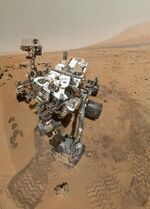Astronomy:2012 KT42
| Designations | |
|---|---|
| Minor planet category |
|
| Orbital characteristics[1] | |
| Epoch 13 January 2016 (JD 2457400.5) | |
| Uncertainty parameter 5 | |
| |{{{apsis}}}|helion}} | 2.4839 astronomical unit|AU (371.59 Gm) |
| |{{{apsis}}}|helion}} | 0.71144 AU (106.430 Gm) |
| Periastron | 94.628° |
| 1.5977 AU (239.01 Gm) | |
| Eccentricity | 0.55470 |
| Orbital period | 2.02 yr (737.60 d) |
| Mean anomaly | 261.31° |
| Mean motion | 0° 29m 17.052s / day |
| Inclination | 2.1932° |
| Longitude of ascending node | 69.515° |
| 259.13° | |
| Earth MOID | 0.000968708 AU (144,916.7 km) |
| Physical characteristics | |
| Dimensions | ~4–10 metres[2] |
| Rotation period | 0.06057 h (3.634 min) |
| Absolute magnitude (H) | |
2012 KT42 is an Apollo near-Earth asteroid first observed by astronomer Alex R. Gibbs of the Mount Lemmon Survey with a 1.5-meter reflecting telescope on 28 May 2012.
Overview
The asteroid had a close approach to the Earth on 29 May 2012, approaching to only ~8950 miles (~14,440 km) above the planet's surface. This means 2012 KT42 came inside the Clarke Belt of geosynchronous satellites. In May 2012, the estimated 5- to 10-metre-wide asteroid ranked #6 on the top 20 list of closest-approaches to Earth. There was no danger of a collision during the close approach. 2012 KT42 passed roughly 0.01 astronomical unit|AU (1,500,000 km; 930,000 mi) from Venus on 8 July 2012.[1]
It is estimated that an impact would produce an upper atmosphere air burst equivalent to 11 kt TNT,[4] roughly equal to Hiroshima's Little Boy. The asteroid would be vaporized as these small impacts occur approximately once per year. A comparable-sized object caused the Sutter's Mill meteorite in California on 2 April 2012. It was removed from the Sentry Risk Table on 30 May 2012.[5]
References
- ↑ 1.0 1.1 1.2 "JPL Close-Approach Data: (2012 KT42)". http://ssd.jpl.nasa.gov/sbdb.cgi?sstr=2012KT42;cad=1#cad. Retrieved 1 April 2016.
- ↑ "Conversion of Absolute Magnitude to Diameter". Minor Planet Center. http://www.minorplanetcenter.net/iau/lists/Sizes.html. Retrieved 2012-05-30.
- ↑ "2012 KT42 Orbit". Minor Planet Center. 2012-05-29. http://www.minorplanetcenter.net/db_search/show_object?object_id=2012+KT42. Retrieved 2012-05-30.
- ↑ "Earth Impact Risk Summary: 2012 KT42". NASA/JPL Near-Earth Object Program Office. http://neo.jpl.nasa.gov/risk/2012kt42.html. Retrieved 2012-05-29.[|permanent dead link|dead link}}]
- ↑ "Date/Time Removed". NASA/JPL Near-Earth Object Program Office. http://neo.jpl.nasa.gov/risk/removed.html. Retrieved 2012-05-30.
External links
- JPL Small-Body Database Browser for 2012 KT42
- 2012 KT42 - Close Approach (Remanzacco Observatory in Italy)
- Images from Flyby (spaceweather.com)
- MPEC 2012-K66 : 2012 KT42 (Minor Planet Center Discovery announcement)
- Planetary Defense Blog post on 2012 KT42
- Video: Tiny Asteroid 2012 KT42 Crossing The Sky (universetoday 29 May 2012)
- The Peculiar Flyby of Asteroid 2012 KT42 (Pasquale Tricarico : 29 May 2012)
- 2012 KT42 at NeoDyS-2, Near Earth Objects—Dynamic Site
- Ephemeris · Obs prediction · Orbital info · MOID · Proper elements · Obs info · Close · Physical info · NEOCC
- 2012 KT42 at ESA–space situational awareness
- 2012 KT42 at the JPL Small-Body Database
 |



